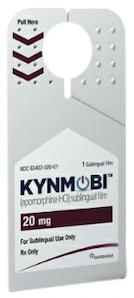Apomorphine Disease Interactions
There are 10 disease interactions with apomorphine.
- Alcoholism
- Asthma
- Cardiovascular/cerebrovascular disease
- Dyskinesia
- Hypersomnia
- Liver disease
- QT prolongation
- Renal dysfunction
- Hypotension
- Psychosis
Apomorphine (applies to apomorphine) alcoholism
Moderate Potential Hazard, Moderate plausibility.
In a study of healthy subjects, the hypotensive effect of apomorphine on systolic and diastolic blood pressure was exacerbated by the concomitant use of alcohol. Patients should avoid alcohol when using apomorphine.
Apomorphine (applies to apomorphine) asthma
Moderate Potential Hazard, Moderate plausibility.
Apomorphine products contain sodium metabisulfite, a sulfite that may cause allergic-type reactions (including anaphylactic symptoms and life-threatening or less severe asthmatic episodes) in certain susceptible patients. While the overall prevalence in the general population is unknown and probably low, sulfite sensitivity is seen more often in patients with asthma than in those without asthma.
Apomorphine (applies to apomorphine) cardiovascular/cerebrovascular disease
Moderate Potential Hazard, Moderate plausibility. Applicable conditions: Cardiovascular Disease, Cerebral Vascular Disorder
Apomorphine has been shown to reduce resting systolic and diastolic blood pressure and may have the potential to exacerbate cardiac and cerebral ischemia in patients with known cardiovascular and cerebrovascular disease. If patients develop signs/symptoms of cardiac or cerebral ischemia, prescribers should reevaluate the continued use of apomorphine.
Apomorphine (applies to apomorphine) dyskinesia
Moderate Potential Hazard, Moderate plausibility. Applicable conditions: Tardive Dyskinesia
Apomorphine may cause dyskinesia or exacerbate preexisting dyskinesia. Patients should be informed that new or worsening dyskinesia may occur.
Apomorphine (applies to apomorphine) hypersomnia
Moderate Potential Hazard, Moderate plausibility. Applicable conditions: Sleep Disorder
Somnolence is commonly associated with apomorphine. Patients treated with apomorphine have also reported falling asleep while engaged in activities of daily living, including the operation of motor vehicles, which sometimes resulted in accidents. Falling asleep while engaged in activities of daily living usually occurs in patients with preexisting somnolence, although patients may not give such a history. Before starting treatment with apomorphine, patients should be informed of the risk of drowsiness and asked about factors that could increase the risk with apomorphine, such as the presence of sleep disorders.
Apomorphine (applies to apomorphine) liver disease
Moderate Potential Hazard, Moderate plausibility.
Apomorphine has not been studied in patients with severe liver dysfunction. Because apomorphine concentration and exposure (AUC and Cmax) is increased, caution should be exercised if apomorphine is administered to patients with mild or moderate liver dysfunction; these patients should be closely monitored.
Apomorphine (applies to apomorphine) QT prolongation
Moderate Potential Hazard, Moderate plausibility. Applicable conditions: Electrolyte Abnormalities, Hypokalemia, Long QT Syndrome
The risks/benefits of apomorphine treatment should be considered before starting this drug in patients with risk factors for prolonged QTc. There is a dose-related prolongation of QTc interval after apomorphine exposure similar to that achieved with therapeutic doses of this drug. For the intermittent injection formulation, doses greater than 6 mg do not provide additional clinical benefit and are not recommended. Drugs that prolong QTc interval have been associated with torsades de pointes and sudden death. The link between QTc prolongation and torsades de pointes is most apparent with larger increases (20 msec and greater), but smaller QTc prolongations may also increase risk, particularly in susceptible patients (e.g., those with hypokalemia, hypomagnesemia, bradycardia, genetic predisposition [such as congenital QT interval prolongation], or concomitant use of other drugs that prolong QTc interval). Although no occurrence of torsades de pointes was reported in association with apomorphine at recommended doses in clinical trials, an increased risk cannot be ruled out due to limited experience.
Apomorphine (applies to apomorphine) renal dysfunction
Moderate Potential Hazard, Moderate plausibility.
Apomorphine has not been studied in patients with severe renal dysfunction. For patients with mild or moderate renal dysfunction using the intermittent injection formulation, the test dose and starting dose of apomorphine should be reduced to 1 mg. For patients with mild or moderate renal dysfunction using the continuous infusion formulation, the initial extra dose of apomorphine is 0.5 to 1 mg and should not exceed 1 mg; no adjustment is needed for the continuous dose, maximum recommended daily dose, or subsequent extra doses after the initial extra dose.
Dopamine agonists (applies to apomorphine) hypotension
Moderate Potential Hazard, Moderate plausibility.
Dopamine agonists may impair the systemic regulation of blood pressure, with resultant orthostatic hypotension at any time, but especially during dose escalation. Additionally, patients with Parkinson's disease may have an impaired capacity to respond to an orthostatic challenge. For these reasons, patients with Parkinson's disease (or restless legs syndrome) who are being treated with dopaminergic agonists typically require careful monitoring for signs/symptoms of orthostatic hypotension, especially during dose escalation, and should be advised of this risk.
Dopaminergic antiparkinsonian agents (applies to apomorphine) psychosis
Moderate Potential Hazard, Moderate plausibility.
Ordinarily, patients with major psychotic disorder should not be treated with dopaminergic antiparkinsonian agents, because of the risk of exacerbating psychosis. Hallucinations and psychotic-like behavior have been reported with dopaminergic medications. In addition, certain medications used to treat psychosis may exacerbate the symptoms of Parkinson's disease and may decrease the effectiveness of these drugs. The use of bromocriptine in patients with severe psychotic disorders is not recommended.
Switch to professional interaction data
Apomorphine drug interactions
There are 598 drug interactions with apomorphine.
Apomorphine alcohol/food interactions
There is 1 alcohol/food interaction with apomorphine.
More about apomorphine
- apomorphine consumer information
- Check interactions
- Compare alternatives
- Pricing & coupons
- Reviews (4)
- Side effects
- Dosage information
- During pregnancy
- Drug class: dopaminergic antiparkinsonism agents
- Breastfeeding
- En español
Related treatment guides
Drug Interaction Classification
| Highly clinically significant. Avoid combinations; the risk of the interaction outweighs the benefit. | |
| Moderately clinically significant. Usually avoid combinations; use it only under special circumstances. | |
| Minimally clinically significant. Minimize risk; assess risk and consider an alternative drug, take steps to circumvent the interaction risk and/or institute a monitoring plan. | |
| No interaction information available. |
Further information
Always consult your healthcare provider to ensure the information displayed on this page applies to your personal circumstances.


